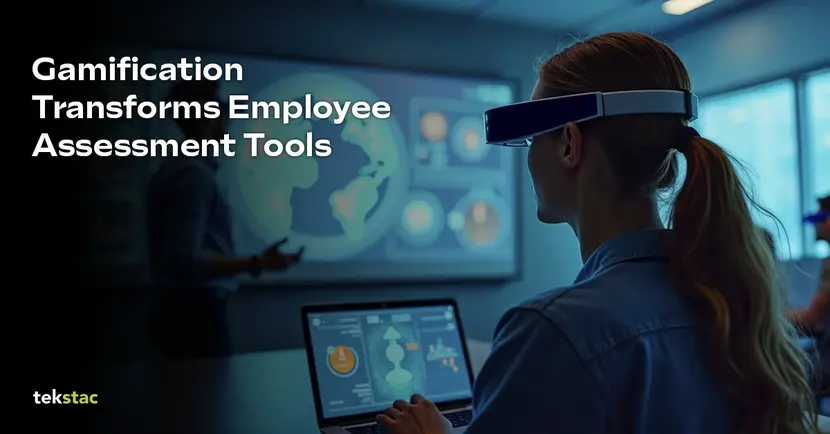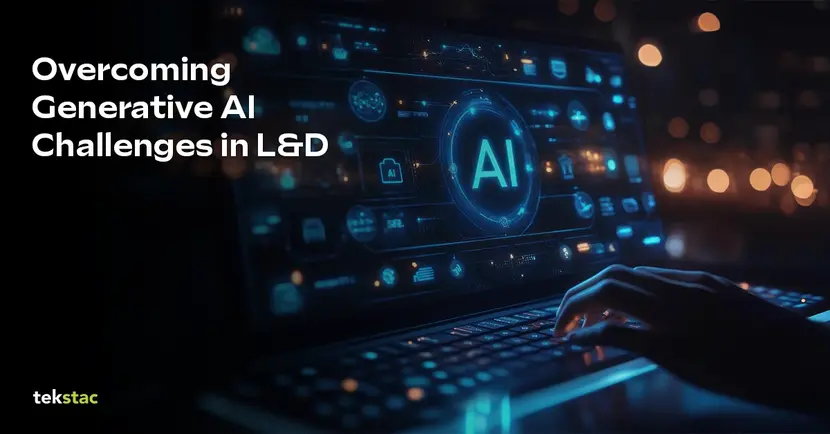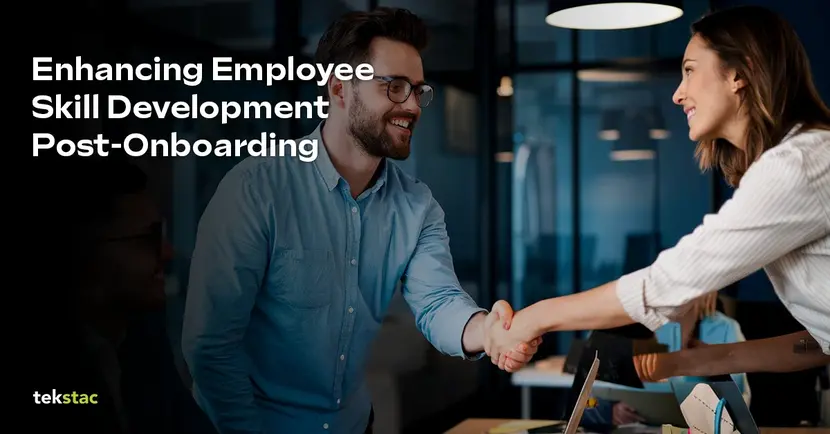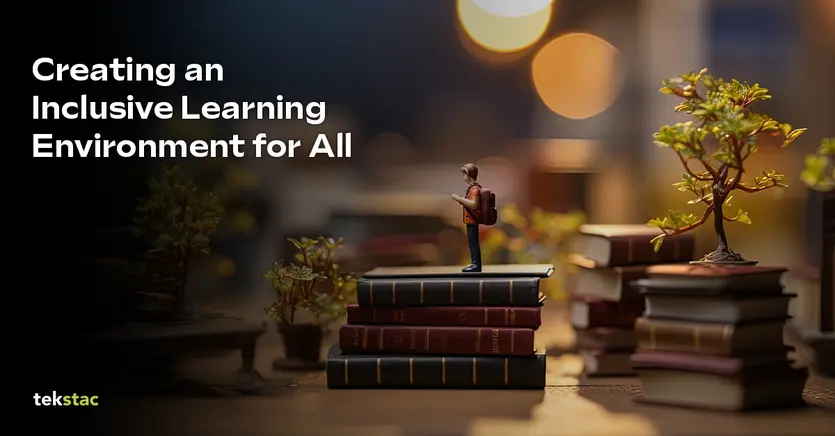20 Best Holiday Books to Inspire HR & L&D Strategy in 2026
The holiday season is more than a break; it’s a pause. A moment to step away from calendars and KPIs, and refuel the mind with inspiration we rarely have time for during the year. And what better way to recharge than with a holiday books that:
- Sharpens our perspective
- Strengthens strategy
- Deepens people understanding
- Helps us shape meaningful work
20 Best Holiday Books for HR & Learning Leaders
We’ve curated 20 highly recommended holiday reading list reads across Leadership & Business, AI & Future of Work, HR & L&D, and Classics. Each one contributes in a tangible way to leading better, developing people smarter, and building organizations that thrive.
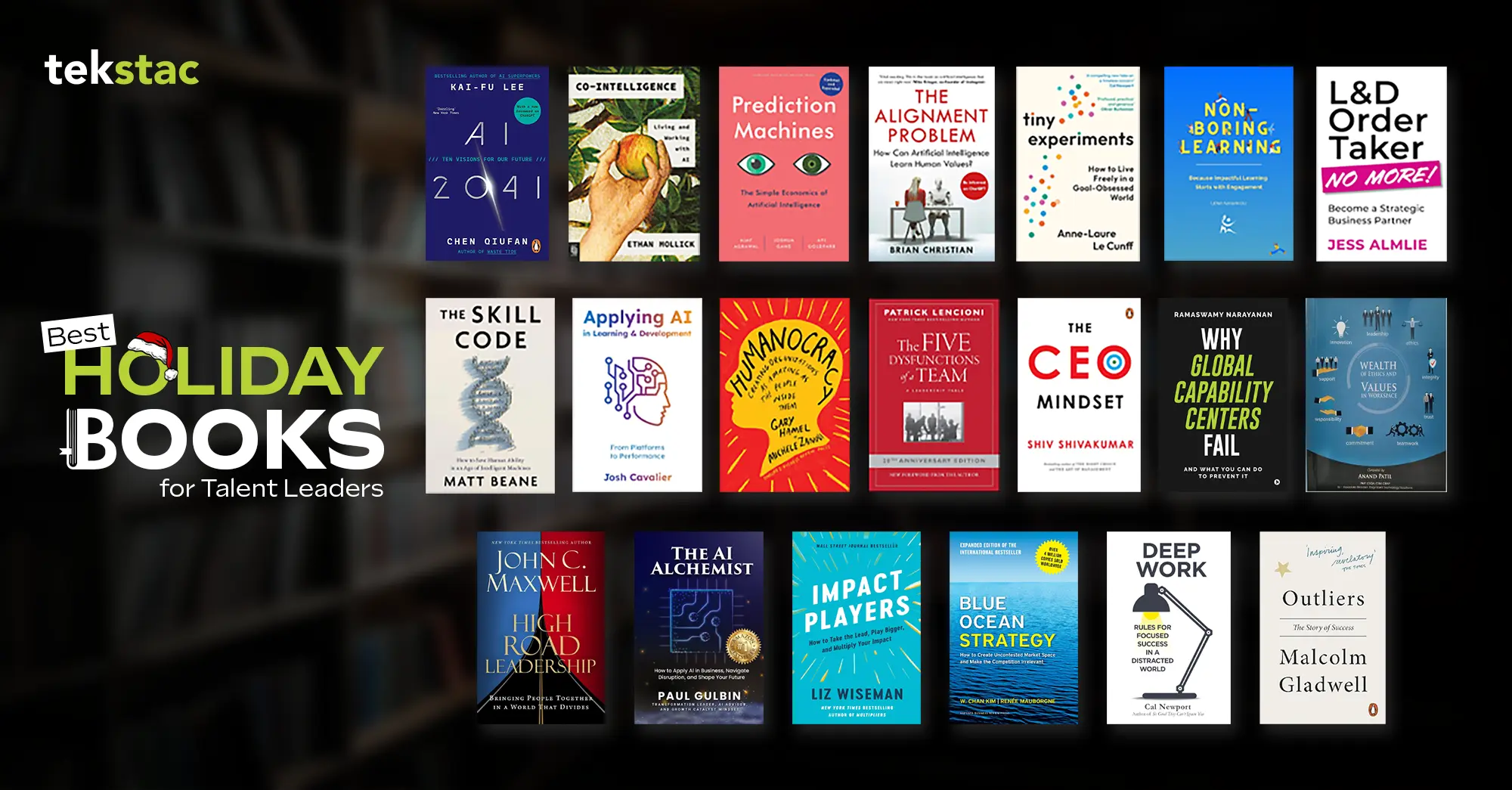
AI & Future of Work
1. AI 2041 – Kai-Fu Lee & Chen Qiufan
One of the best year-end reading recommendations include this book which combines science fiction and analysis to show how AI reshapes jobs, business, and society by 2041.
2. Co-Intelligence – Ethan Mollick
Practical playbook for collaborating with AI ethically and effectively in workplace teams.
3. Prediction Machines – Ajay Agrawal, Joshua Gans & Avi Goldfarb
Shows how AI simplifies prediction tasks and offers frameworks for applying AI strategically in business decisions.
4. The Alignment Problem – Brian Christian
Explains the importance of aligning AI systems with human values and organizational goals.
Why Leaders Must Read This:
Understanding AI is no longer optional. These books equip leaders to anticipate disruption, integrate AI ethically, and prepare their teams for a future where human and machine collaboration drives results.
“India ranks 2nd globally in average reading hours, with readers spending nearly 352 hours a year reading—making intentional holiday reading a powerful reset for leaders.”
HR, Talent & L&D Innovation
5. Tiny Experiments – Anne-Laure Le Cunff
Guides L&D leaders to test new learning approaches with low-risk experiments. Encourages micro-iterations that produce real insights.
6. Non-Boring Facilitation – Lena Nasiakou
A hands-on guide for engaging interactive facilitation. Covers gamified methods and somatic approaches to make learning sessions more effective.
7. L&D Order Taker No More – Jess Almlie
Encourages L&D professionals to move from request-based training to strategic impact. Focuses on aligning learning with organizational goals. One of the popular HR strategy books.
8. The Skill Code – Matt Beane
Explains how to preserve craft skills and mentor talent in the world of automation. Offers frameworks for skill development and human-centered learning.
9. Applying AI in Learning & Development – Josh Cavalier
Covers practical applications of AI in learning and performance. Shows how to leverage adaptive learning platforms and measure ROI.
Why Leaders Must Read This:
For HR and L&D leaders, these holiday books provide actionable tools to build learning cultures, upskill employees, and ensure organizational agility in the AI-driven era.
Leadership, Culture & Business Performance
10. Humanocracy – Gary Hamel & Michele Zanini
Shows how bureaucracy slows organizations and crushes initiatives. Learn how autonomy, trust, and distributed decision-making outperform top-down control. A must-read holiday book for leaders.
11. Five Dysfunctions of a Team – Patrick Lencioni
Offers a practical framework for building cohesive teams. Explains how trust, accountability, and alignment can overcome collaboration gaps.
12. The CEO Mindset – Shiv Shivkumar
The author shares lessons from his career and 13 other leaders, emphasizing prioritization, reflection, time management, relationships, and trust. This book guides readers to cultivate leadership values and habits for a meaningful career.
13. Why Global Capability Centers Fail: And What You Can Do to Prevent It – Ramaswamy Narayanan
Examines why many GCCs underdeliver and provides practical frameworks, case studies, and scorecards. A must-read for leaders managing global teams to transform transactional centers into strategic, value-creating platforms.
14. Wealth of Ethics and Value in Workspace – Anand Patil
Focuses on ethics, values, and leadership in the workplace. Demonstrates how responsible, value-driven leadership can enhance both culture and performance.
15. High Road Leadership – John Maxwell
This book provides practical frameworks to help leaders elevate team trust, navigate conflict with maturity, and create cultures where people choose collaboration over competition.
Why Leaders Must Read This:
These are one of the best books to read during holidays that help leaders rethink culture, strategy, and influence. They provide frameworks to inspire teams, make smarter decisions, and create organizations that thrive.
Jobs & Skilling in the AI Era
16. The AI Alchemist: How to Apply AI in Business, Navigate Disruption, and Shape Your Future – Paul Gulbin
Explores AI-driven role transformations and skill requirements. Provides strategies for reskilling and staying relevant in evolving workplaces.
17. Impact Players – Liz Wiseman
Focuses on identifying high-impact contributors in organizations. Guides leaders on building teams with the skills that drive business results.
Why Leaders Must Read This:
Job roles and skill demands are changing rapidly. These holiday books help leaders design future-ready roles, identify talent gaps, and reskill teams for maximum impact.
Classics / Timeless Reads
18. Blue Ocean Strategy – W. Chan Kim & Renée Mauborgne
A groundbreaking framework that shows leaders how to move beyond crowded markets and create uncontested spaces for growth. The book blends research and real-world case studies to reveal how value innovation, strategic clarity, and bold thinking can unlock new opportunities.
19. Deep Work – Cal Newport
A modern classic that argues our ability to focus without distraction is becoming a rare and extremely valuable skill. Newport shares practical methods to build deep concentration, reduce digital noise, and do more meaningful work in less time. A highly relevant holiday books for leaders shaping productivity norms in an always-on workplace.
20. Outliers – Malcolm Gladwell
Gladwell explores what truly sets high achievers apart, revealing how success is shaped not only by talent, but also by opportunity, timing, environment, cultural influences, and deliberate practice. A timeless classic indeed!
Why Leaders Must Read This:
Classics never go out of style. They provide timeless principles on team dynamics, strategic thinking, and human behavior, essential for making informed and impactful decisions.
Bonus Read
AI Snake Oil: What Artificial Intelligence Can Do, What It Can’t, and How to Tell the Difference – Arvind Narayanan & Sayash Kapoor
A sharp, evidence-based guide that cuts through inflated AI promises. It arms leaders with practical frameworks to make informed, ethical, and high-impact decisions in AI-driven workplaces, without falling for buzzwords.
Conclusion: Holiday Books That Inspire Real Impact
These holiday books blend actionable insights on leadership, HR strategy, talent development, and AI-driven transformation. Some of these titles are well-known classics in business and leadership, staples that many leaders revisit year after year for a reason.
Others are underrated gems, books you may not find in every mainstream list, yet they carry perspectives that can shift how we lead, learn, and design work for the future.
Even if one book here sparks a new idea, challenges a belief, or helps you take a better decision, this holiday reading list will have done its job.
Because sometimes, one powerful insight…
is all it takes to change the game.
Gamified Employee Assessment Tools: The Future of Evaluations in 2025
Gamification in Employee Assessment Tools is the next big move in 2025. Imagine a future where employees look forward to assessments. Sounds unreal? That’s exactly what Gamified Employee Assessment Tools are making possible in 2025.
Disengaged employees already cost companies $8 trillion globally, according to Gallup. Companies are rushing toward the new trend of gamification in employee assessment tools, and so should you!
Through this article, we want to equip you with everything related to the buzz of gamified assessment tools in 2025. Ready? Free your employees and team from generic frameworks. Leapfrog to a world of immersive and interactive experience in your learning programs.
But, first things first!
What is Gamification?
Gamification incorporates game-like elements such as points, badges, leaderboards, and challenges into workplace activities. Insights that are actionable, evaluations that are interactive, and a process that’s less stressful and enjoyable is the foundation of gamified employee assessment. A playful combination of all the elements is what makes gamification a critical trend to watch out for in 2025.
However, that’s not all, there are many key factors behind organizations, all sizes, across the globe choosing gamified assessment tools.
Key Drivers Behind the Rise of Gamified Employee Assessment Tools in 2025
A Growth Engineering survey found that 90% of employees feel highly motivated by gamified tools. Blending gamification with cutting-edge AI, AR/VR, and data analytics, ensures your workforce stays engaged, future-ready, and consistently productive.
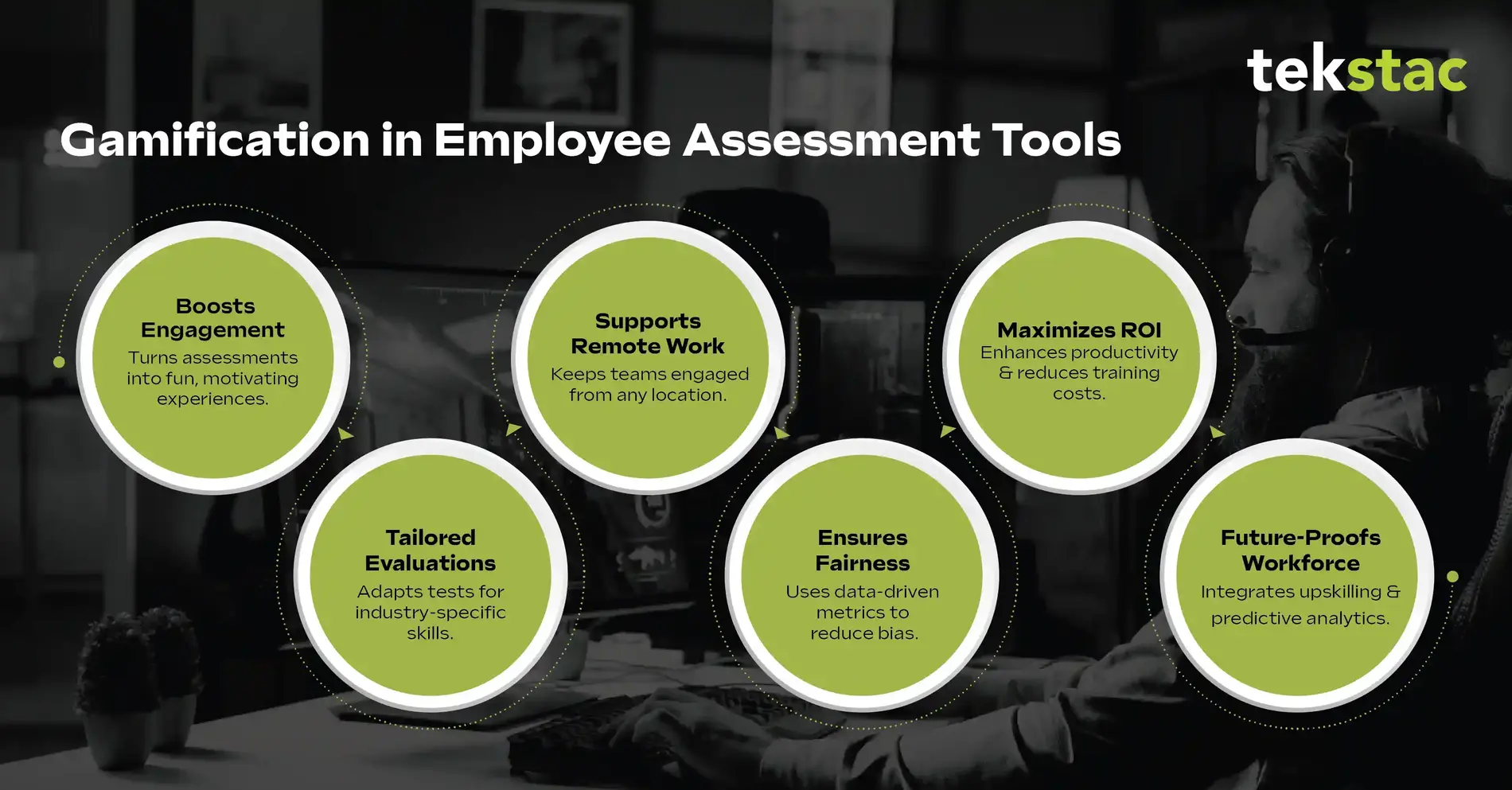
Let’s dive more and see what’s the reason behind the shift towards gamification in employee assessment tools in 2025.
1. Boosts Employee Engagement Across Industries:
By transforming assessments into enjoyable activities, gamification ensures employees are motivated, productive, and aligned with company goals.
2. Tailors Assessments to Specific Needs:
Infusing gamification in employee assessment tools, you can customize the evaluation for industry-specific challenges, from coding tests for IT professionals to sales simulations for retail.
3. Supports Hybrid and Remote Work Models:
Virtual gamified assessments keep teams engaged and evaluated, regardless of their location.
4. Promotes Fair and Transparent Evaluations:
Gamification in the employee assessment tools reduces biases. It focuses on measurable performance metrics, ensuring fair and accurate assessments.
5. Drives ROI Through Measurable Impact:
Gamified assessments improve productivity, reduce training costs, and increase retention. Additionally, it offers organizations a strong return on investment.
6. Future-Proofs the Workforce:
By incorporating upskilling and predictive analytics, it helps employees stay relevant in an ever-evolving market.
How To Implement Gamified Assessment?
1. IT and Tech Industries
Code Challenges with Real-Time Feedback:
Developers can solve gamified coding problems, earning instant feedback and badges. It makes skill evaluation seamless as well as engaging for employees.
AI-Driven Learning Pathways:
Platform like Tekstac recommends personalized upskilling modules based on assessment outcomes, helping employees stay ahead of evolving technologies.
Hackathons for Skill Validation:
Gamified hackathons can be developed for employees where performance metrics assess creativity, technical skills, and problem-solving abilities.
2. Retail and Sales
Sales Scenarios with AR/VR:
Sales employees handle virtual customer interactions, building skills in negotiation and objection handling. The process can include rewards for successful outcomes.
Gamified Upskilling Modules:
Equipping employees with new sales techniques through interactive modules that track progress and reward achievements is a solid take.
Leaderboards to Drive Motivation:
Building Gamified leaderboards to foster healthy competition is a great way to start with gamification of employee assessment tools in 2025. Displaying sales metrics can help encourage employees to outperform while boosting morale.
3. Manufacturing and Operations
Safety Training Simulations:
Creation of immersive scenarios for employees to learn safety protocols is a way forward. The gamified assessment tool can include earning points for accuracy and speed. This will help in reducing workplace risks.
Process Optimization Challenges:
Gamified tasks encourage employees to suggest improvements in operations, fostering collaboration and innovation.
Interactive Progress Dashboards:
Tekstac’s dashboards track and reward employee milestones. It also helps ensure transparency and encourage consistent performance.
4. Education and Training
Knowledge Retention Through Quizzes:
Interactive quizzes with rewards ensure employees retain vital training knowledge. It is a boon in driving better workplace applications.
Behavioral Skill Assessments:
Group challenges can help you assess teamwork, leadership, and communication. It also offers insights into interpersonal strengths.
Gamified Certification Programs:
In order to make learning paths motivating and achievement-focused, rewarding employees for completing certifications, can help.
5. Healthcare
Compliance Training with Gamification:
You can provide compliance training to employees easily with the help of Gamified assessment tools in 2025. Employees can complete mandatory compliance training through interactive modules, earning badges for accuracy and adherence.
Patient Handling Simulations with AR:
Healthcare professionals can practice virtual scenarios, honing critical decision-making skills while receiving real-time feedback.
Tracking Performance Metrics:
Gamification in employee assessment tools ensure that every healthcare professional’s progress is tracked and reported. In return, enabling better evaluations.
Case Study: Microsoft’s Gamified Employee Assessment Strategy
Microsoft, a global leader in technology and innovation, has continuously sought ways to enhance its employee development programs. The company recently recognized that traditional performance assessments, which focused solely on numerical ratings and feedback, were insufficient to foster engagement and continuous growth.
How Microsoft Transformed Employee Assessments with Gamification
As a result, Microsoft sought to revamp its employee assessments by integrating gamification, providing employees with a more engaging, rewarding, and comprehensive way to assess their skills.
Microsoft introduced gamified assessments as part of their internal learning platform, “Microsoft Learn” with the goal of blending professional development with fun and competition.
Through interactive challenges, quizzes, and problem-solving scenarios, employees could assess their performance in real-time. As employees completed modules, they earned points, badges, and had their progress showcased on leaderboards.
To tailor the experience, Microsoft integrated gamification across different roles, from software developers to project managers.
For example, developers participated in coding challenges, earning badges for completing levels or solving coding problems within a set time. These gamified assessments were designed to be both educational and motivational, with a focus on increasing productivity and driving skill development.
The gamified assessment program had a significant impact on Microsoft’s workforce. Employee engagement in training and assessment modules increased by 40%, with employees expressing greater enthusiasm for participating in assessments. In fact, 80% of employees reported that they felt more motivated to complete their training due to the gamified elements.
Furthermore, performance evaluations post-assessment showed improvements in both technical skills and soft skills, as employees felt more invested in their learning paths. The company also noticed a reduction in the time spent on traditional performance reviews, as the gamified assessments provided instant feedback and measurable data for managers.
Microsoft’s gamified employee assessments allowed the company to foster a culture of continuous learning and development while keeping employees motivated and engaged. By offering personalized learning pathways, real-time feedback, and rewarding achievements, Microsoft not only improved employee skills but also created a more transparent, enjoyable, and effective evaluation process.
Gamification in Employee Assessment:
Gamification is more than a buzzword, it’s a transformative approach to employee assessment. Tekstac’s innovative platform redefines evaluations, blending interactive technologies with actionable insights to drive engagement and productivity.
From immersive AR simulations to personalized learning paths and predictive analytics, Tekstac equips organizations to unlock their workforce’s full potential.
With Tekstac, your team will not only meet but exceed the demands of 2025. Ready to redefine your employee assessments? Partner with Tekstac to build an engaged, future-ready workforce today.
Employee Assessment Tools FAQs
1. What does gamification mean in employee assessments?
Gamification in employee assessments involves using game-like features such as points, rewards, and interactive tasks to make performance evaluations more engaging and motivating.
2. How does gamification improve employee assessments?
It boosts participation, provides real-time feedback, and makes evaluations more enjoyable, leading to higher engagement and accurate performance tracking.
3. Why are companies adopting gamified assessment tools in 2025?
Companies are using gamified assessments to enhance productivity, reduce biases, and ensure continuous skill development in a hybrid work environment.
4. Can gamification be applied to different industries?
Yes, gamified assessment tools can be customized for IT, sales, healthcare, and manufacturing, aligning evaluations with specific industry needs.
How to Tackle the Top Generative AI Challenges in Learning and Development by 2025
What Are the Challenges of Generative AI?
What if your training programs could truly adapt to every learner’s needs? Generative AI (Artificial Intelligence) is reshaping Learning and Development (L&D) by providing adaptive, scalable, and data-driven solutions tailored to diverse learner profiles.
Say goodbye to outdated, one-size-fits-all training. AI brings new possibilities, from creating personalized learning paths to delivering interactive content and automating assessments.
But as exciting as these advancements are, they come with challenges that demand attention. Tackling Generative AI challenges in L&D is essential for ethical and effective adoption by 2025.
Key Challenges of Generative AI in L&D
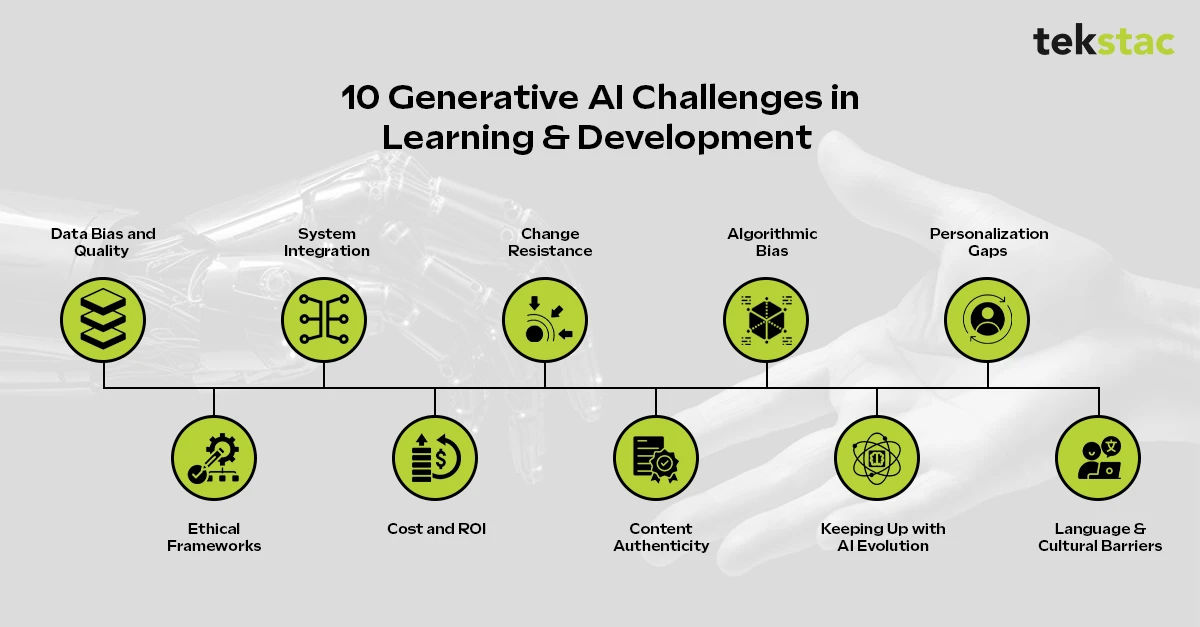
1. Data Bias and Quality: Ensuring Fairness in Learning Outcomes
The first major challenge lies in tackling algorithmic bias and data quality issues. A 2024 report highlighted that 42% of organizations struggle with poor data quality, which undermines the accuracy of AI outputs.
Bias in datasets can perpetuate stereotypes and negatively impact the inclusivity of training materials. For example, biased AI models might produce content that unintentionally alienates certain groups, eroding trust and engagement among learners.
To overcome this, organizations must prioritize:
- Using diverse and representative datasets.
- Implementing proactive bias detection and correction measures.
- Conducting regular audits of AI systems.
These actions ensure fairness while maintaining the reliability of AI-driven learning systems.
2. Ethical Frameworks: Balancing Innovation with Integrity
One of the biggest Generative AI challenges lies in the transparency of generative AI models and algorithms. Often referred to as “black boxes,” they make it hard to understand how decisions are made, raising significant ethical concerns. This opacity can create dilemmas when it comes to accountability and trust. To address these issues, global powers like the U.S. and China are stepping up by advancing AI regulations aimed at promoting transparency and fairness.
For businesses, this means aligning with emerging ethical standards to ensure they not only stay compliant but also foster trust among their teams and stakeholders. Tackling these Generative AI Challenges with a proactive approach is essential for creating AI systems that are both reliable and equitable.
Key strategies include:
- Deploying explainable AI tools to foster transparency.
- Establishing real-time audits to monitor system outputs.
- Crafting policies that ensure fairness and inclusivity.
By embedding ethics into their L&D strategies, organizations can create AI-powered solutions that are both innovative and trustworthy.
3. Infrastructure and Integration: Bridging Legacy Systems with Modern AI
Integrating generative AI into existing systems presents technical challenges, especially for organizations reliant on legacy learning management systems (LMS). These traditional platforms often lack the flexibility required for dynamic AI tools, leading to compatibility issues and inefficiencies.
To address this:
- Adopt middleware solutions to bridge gaps between old and new systems.
- Transition to modern AI-first platforms that are built to overcome the shortfalls in traditional skilling tools.
- Collaborate across IT and L&D teams to align technical and educational priorities.
Such strategies minimize disruptions while enabling seamless integration of cutting-edge tools.
4. High Costs of Development and Deployment: A Path to High ROI
While the financial investment in generative AI can seem significant—ranging from $100,000 to $600,000 per project, according to a Scaleup Ally report—the potential return on investment (ROI) makes it a game-changer for Learning and Development.
AI-based training systems can streamline workflows, enhance learner engagement, and provide data-driven insights that improve program effectiveness, ultimately saving both time and resources.
To maximize ROI, organizations can:
- Focus on essential features through a Minimum Viable Product (MVP) approach.
- Utilize pre-built AI platforms and cloud-based services to minimize upfront expenses.
- Partner with technology experts for scalable, cost-efficient solutions.
By aligning investments with measurable outcomes, businesses can ensure that every dollar spent contributes to creating impactful and sustainable L&D programs.
5. Resistance to Change: Building Trust and Confidence
Integrating AI into Learning & Development (L&D) presents notable Generative AI Challenges, particularly concerning organizational resistance to change. Employees often view AI as a potential threat to their job security, while leadership may hesitate due to financial implications. A 2024 PwC report reveals that 39% of workers are apprehensive that AI could render their current skills obsolete.
To overcome resistance, organizations should:
- Promote open communication to alleviate fears and build trust.
- Invest in upskilling programs that empower employees to engage with AI confidently.
- Implement pilot programs to demonstrate the tangible benefits of AI.
Through collaboration and education, businesses can foster a culture of acceptance and enthusiasm for technological innovation.
6. Content Authenticity: Ensuring Accuracy and Credibility
Generative AI models occasionally produce misleading or plagiarized content, raising concerns about authenticity. A 2023 study introduced the Hallucination Evaluation benchmark for Large Language Models (HaluEval), revealing that models like ChatGPT generate hallucinated content—plausible yet unverifiable information—in approximately 19.5% of their responses.
Solutions include:
- Incorporating human oversight to review and validate AI-generated materials.
- Leveraging explainable AI to trace content origins and ensure transparency.
- Using AI watermarking technologies to verify authenticity.
By implementing these measures, organizations can maintain the integrity of their training programs.
7. Overcoming Algorithmic Bias
One of the most significant Generative AI Challenges lies in addressing algorithmic bias, which can undermine equitable learning opportunities and reinforce existing inequalities. For example, career guidance tools powered by AI might unintentionally push learners away from certain professions if the underlying data reflects societal biases.
Addressing this requires:
- Regular audits to detect and rectify biases.
- Engaging diverse voices during the design phase.
- Developing equitable algorithms that prioritize fairness and inclusivity.
These efforts ensure AI tools empower all learners, regardless of background.
8. Technological Evolution: Keeping Pace with Rapid Advancements
As AI technologies evolve rapidly, staying updated becomes a challenge for L&D teams. Traditional training models risk obsolescence if they fail to adapt.
Recommended strategies include:
- Investing in continuous upskilling for L&D professionals.
- Building flexible systems that accommodate new technologies seamlessly.
- Prioritizing inclusive design to address diverse learner needs.
By embracing agility, organizations can future-proof their L&D initiatives.
9. Lack of Personalization: Bridging the Gap for Individual Learners
Despite its potential, generative AI often struggles to deliver true learner personalization. Many systems rely on standardized datasets, which fail to account for individual preferences, learning styles, or career goals.
To address this, organizations should:
- Invest in adaptive learning platforms that tailor content to individual progress and performance.
- Use advanced analytics to refine training programs based on real-time feedback.
- Incorporate human oversight to balance automation with empathy.
These approaches create more engaging, relevant, and impactful learning experiences.
10. Language and Cultural Barriers: Enhancing Global Accessibility
Generative AI’s limitations in handling diverse languages and cultural contexts present significant challenges for multinational organizations. A 2024 report from the World Economic Forum highlighted that most AI chatbots and language models are trained on only about 100 of the world’s 7,000 languages, with English being the dominant focus.
Organizations can overcome these barriers by:
- Localizing training materials to reflect regional languages and cultural nuances.
- Training AI models on diverse datasets to improve multilingual capabilities.
- Involving local experts to ensure cultural sensitivity and relevance.
By addressing these challenges, businesses can create inclusive L&D programs that resonate with a global workforce.
Opportunities: Unlocking the Positive Impact of Generative AI in L&D
While it’s important to address the challenges, generative AI also opens up exciting opportunities in Learning and Development. By leveraging its capabilities, organizations can:
- Create Personalized Learning Experiences: AI tailors training to individual learners’ needs, boosting engagement and knowledge retention.
- Enhance Productivity with Automation: Automating tasks like content creation, assessments, and progress tracking saves time for both learners and instructors.
- Enable Real-Time Insights: AI-powered analytics provide actionable data, helping organizations refine their programs for better outcomes.
- Expand Global Accessibility: Multilingual and culturally adaptive AI tools allow organizations to reach a diverse global workforce effectively.
Conclusion
By solving the challenges of generative AI, organizations can create better Learning and Development programs that are fair, effective, and help everyone succeed.
For forward-thinking solutions inspired by industry-leading practices, explore a 360° skilling platform that innovative approaches to unlock the full potential of AI-driven L&D.
Leveraging Technology for Employee Skill Development Post-Onboarding
In today’s tech-driven corporate world, employee skill development has moved beyond being a corporate necessity to being a critical advantage. For the HR and L&D executives of tech companies, the challenge is not only in effectively onboarding employees but also in providing continuous post-onboarding skill upgrades, which is in accordance with individual development and organizational goals. Technology has become the foundation of today’s training, providing tools and platforms that enable employee growth and enhance training ROI.
This article discusses the role of HR and L&D professionals in leveraging technology in a highly impactful way to drive employee skill development post-onboarding.
Why Continuous Employee Skill Development Matters Post-Onboarding
Although onboarding can often build the platform for new hires, studies indicate important shortfalls in existing procedures. According to the eLearning Industry State of Employee Experience, 4 in 10 employees found their onboarding training outdated, and 1 in 3 regretted joining the company during this phase. These statistics underscore the need for organizations to not only revamp their on-boarding strategies but also create a seamless continuum of learning post-onboarding.
Beyond onboarding, the need for continuous skill development arises from:
- Technological Evolution: With rapid evolution across industries, employees are required to advance with new tools, systems, and approaches.
- Retention and Engagement: Successful skill development programs encourage employees to be happy and decrease turnover.
- Compliance and Risk Mitigation: Many industries require ongoing training to meet regulatory standards.
Leveraging Technology to Enhance Employee Skill Development
For best results, HR and L&D executives will need to deliberately integrate technology, focusing on solutions that serve both organizational needs and learner needs.
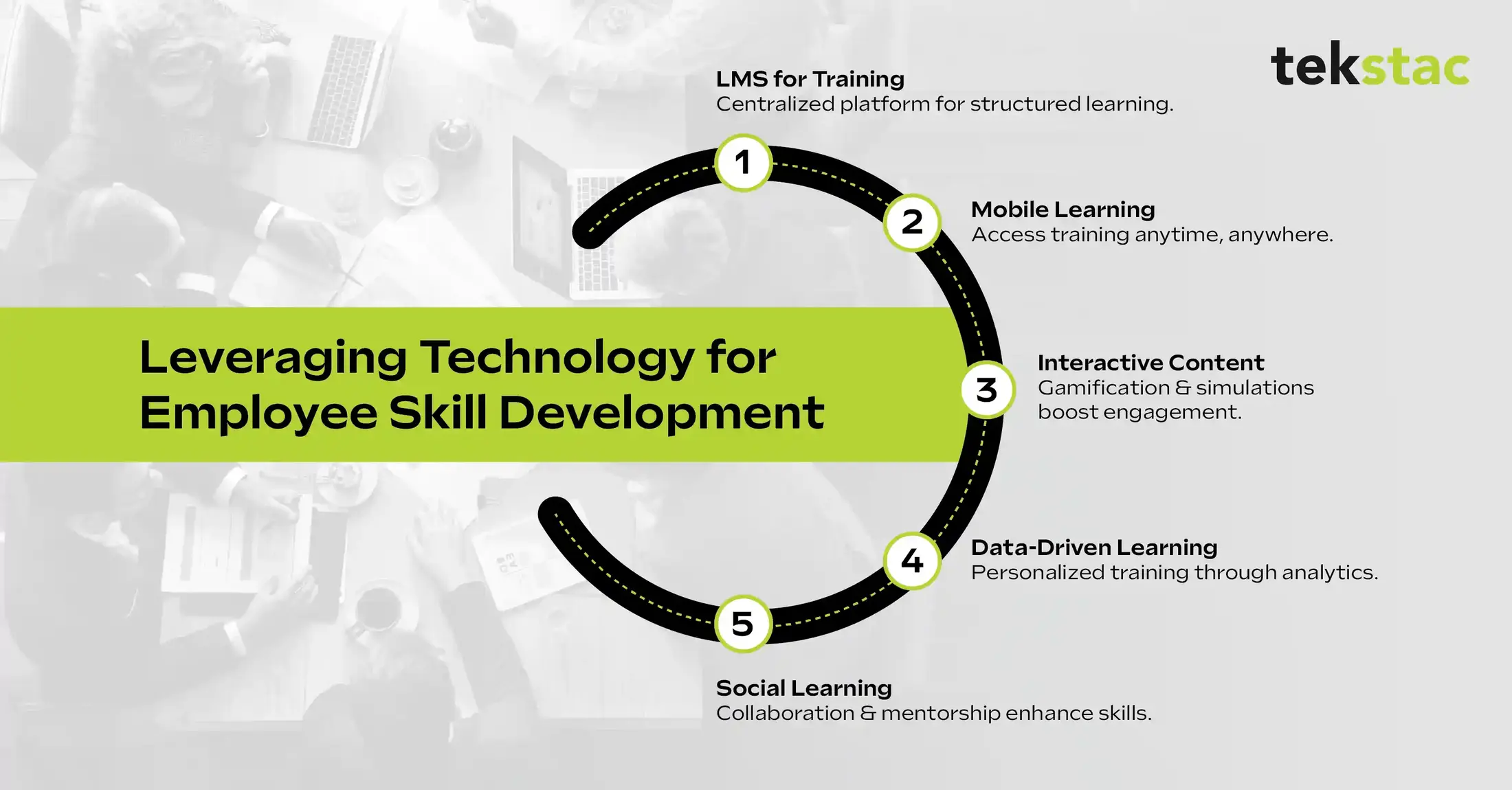
1. Learning Management Systems (LMS): The Foundation of Digital Training
As per the 2023 Training Industry Report, 96% of large and mid-sized companies use Learning Management System (LMS) platforms for training management. These systems play the role of a centralized hub for organizing, distributing, and managing training content.
Nevertheless, the outcome of an LMS is determined by careful design and deployment. Barriers such as unnecessarily complicated user interfaces, absence of administrator support, and uninteresting workflows frequently stall LMS adoption. To address these, organizations should:
- Choose platforms with intuitive user interfaces and strong customer support.
- Make sure LMS functionalities allow personalized learning paths by distinguishing between required and optional courses.
- Incorporate gamification and interactive content tools to increase engagement.
For medium-size companies or who have special requirements, an all in one skilling platforms that combine LMS functionalities can be an option that ensures functionality and freedom.
2. Mobile Learning: Anytime, Anywhere Access
Mobile learning has changed the face of skill development as workers can access training anywhere, anytime. In a society where remote and hybrid work is the new normal, mobile-enabled platforms are available to serve varying learning styles and flexible scheduling needs.
Organizations should ensure mobile platforms:
- Provide bite-sized learning items to fit into hectic schedules.
- Include offline capabilities, allowing learning in low-connectivity areas.
- Give native integration with existing tools, e.g., Slack, Microsoft Teams, for collaborative learning.
3. Interactive Content: Driving Engagement and Retention
Employee engagement can so heavily depend on the training content’s relevance and interaction. Research indicates that the use of interactive components such as videos, simulations, and gamified quizzes enhances retention rates greatly.
For instance:
- Gamification fosters motivation through rewards, leaderboards, and challenges.
- Simulations provide risk-free opportunities for employees to practice skills in real life situations.
- Augmented Reality (AR) and Virtual Reality (VR) technologies are well suited for applications that have an element of “touch” to it (like engineering, or healthcare).
4. Data Analytics: Personalizing the Learning Journey
Perhaps the most revolutionary application of technology in training has been the implementation of data analytics for tailored learning pathways. Based on metrics, such as skills inventory, skills gap, personal skills profile, course completion percentage, quiz score, and level of engagement, organizations can:
- Identify knowledge gaps and tailor content accordingly.
- Predict future skill requirements and proactively design training.
- Offer real-time feedback to allow employees to measure their own progress and establish targets.
For instance, an employee who outperforms in pre-tests for some modules may be exempted from repetitive training procedures, saving time and frustration. This degree of personalization guarantees that learning is meaningful and desirable.
5. Social Learning: Leveraging Collaboration Tools
Collaborative platforms such as Slack, Microsoft Teams, or dedicated skilling forums can be leveraged to support peer-to-peer learning. Social learning fosters a sense of community, encouraging employees to share insights, discuss challenges, and learn from one another.
Key strategies include:
- Providing avenues for employees to discuss training topics through discussion forums.
- Supporting employees to participate with a success story or innovative use of what they have learned.
- Providing virtual mentorship programs that brings in new employees in contact with old employees.
Practical Considerations for Implementing Technology-Driven Learning
1. Align Technology with Organizational Needs
Not all training requires high-tech solutions. The process of conducting a feasibility study allows to know whether technology-as-a-solution fulfils the goals of the organization, objectives and budget. Key steps include:
- Reviewing training objectives and materials.
- Evaluating employee traits, and how they learn.
- Choosing tools to accommodate a wide range of content types such as video and audio, as well as real-time interaction.
2. Addressing Resistance to Change
Technological advancements are frequently met with resistance from both staff and managers. Overcome this by:
- Training for trainers to facilitate efficient platform adoption.
- Providing blended self-paced and instructor-led training for varying comfort levels.
- Proactively and methodically engaging and integrating employee input to enhance systems.
3. Invest in Continuous Improvement
Skill development is a process and not a one-time event. Continuously update training materials based on industry developments, feedback from employees, and changes in business requirements.
The Future of Employee Skill Development: A Hybrid Approach
Although technology is a great facilitator, it should not be used without human interface. Hybrid learning models-integrating digitally-based tools with face-to-face mentorship-provide an integrated approach. For instance, whereas a stand-alone upskilling content platform can provide basic knowledge, face-to-face workshops or individual coaching can be designed to tackle complex or subtle skills.
Conclusion: Building a Future-Ready Workforce
In today’s dynamic business environment, employee skill development is a continuous journey that demands strategic focus, thoughtful planning, and the right tools. Organizations that prioritize ongoing learning create a culture of adaptability and innovation, empowering their employees to meet current challenges and prepare for future opportunities.
To fulfill these objectives, companies need to adopt solutions that integrate modern technologies with pragmatic results. Platforms such as Tekstac illustrate this kind of thinking in that they provide end-to-end skilling solutions to help overcome, for example, some of the biggest challenges in workforce development. From immersive practice labs, to data-intensive evaluations, and real-time learning analytics, these platforms offer a scalable and formal means to talent transformation on a large scale.
By integrating advanced tools with carefully curated content and robust management features, organizations can ensure their training initiatives are both effective and sustainable. Working through skill gaps, nurturing innovation, or maximizing retention, a holistic platform approach can enable HR and L&D leaders to build talent teams prepared for the future of work.
The road to success in the end, rests in thoughtfully tech-enabled approaches that put the employee front and center of the learning experience-converting aspiration to action, skill by skill.
Employee Skill Development FAQs
1. What is the future of employee skill development?
The future is hybrid—blending digital platforms with human mentorship to offer scalable, personalized, and effective learning experiences.
2. Why is continuous skill development important after employee onboarding?
Continuous skill development ensures employees stay updated with evolving technologies, stay engaged, and perform at their best long after the onboarding phase.
3. What’s the best strategy for selecting tech tools for employee training?
Evaluate training goals, employee learning styles, and budget. Choose tools that support multimedia content, scalability, and personalization.
4. How can companies address resistance to new training technologies?
Provide adequate trainer support, blend self-paced with live training, and involve employees in feedback loops to build trust and adoption.
How to Create an Inclusive Learning Environment for a Diverse Workforce
Creating an inclusive learning environment means building a space where everyone feels welcome, valued, and supported. It’s about making sure everyone, regardless of background, can learn, grow, and contribute freely. In modern workplaces, inclusive learning helps teams understand each other better, share different perspectives, and work together more effectively.
According to Forbes report, inclusive teams make decisions 60% faster and are 87% more likely to make better decisions on average.
Organizations thrive when employees feel valued and respected, regardless of their background. So, how can we create learning environments that truly support this dynamic?
Let’s dive into the critical elements of inclusivity and the strategies to integrate them within your team.
Understanding Diverse Workforces in an Inclusive Learning Environment
A diverse workforce brings together people with different backgrounds, experiences, and perspectives within an organization. It’s more than just demographics. It’s about creating an environment where unique talents and viewpoints are valued and empowered.
- Age: Multigenerational teams promote learning across all age groups.
- Gender: Diverse gender participation reduces bias.
- Ethnicity and Culture: Different cultural backgrounds bring fresh perspectives.
- Abilities: Neurodivergent and differently-abled employees offer unique skills and insights.
Diversity means embracing individual differences to drive innovation, creativity, and collective success. It’s about recognizing that each person brings something unique to the team, helping organizations become more adaptable, dynamic, and competitive.
Personalized learning approaches can further enhance workforce diversity by content to individual learning needs and strengths.
When paired with an inclusive learning environment, diverse workforces lead to exponential improvements in employee satisfaction, knowledge retention, and long-term business agility.
What Does an Inclusive Learning Environment Look Like?
An inclusive learning environment is where every employee feels heard, respected, and empowered to learn. It’s about more than just accommodating differences; it’s celebrating them. Characteristics of such environments include:
- Valuing All Voices: Ensuring every individual feels their input matters.
- Respect for Diversity: Acknowledging and respecting cultural, social, and personal differences.
- Flexible Learning Approaches: Adapting teaching methods to accommodate various learning styles.
When inclusivity is prioritized, employees absorb knowledge and feel more confident sharing their perspectives, driving innovation across the board.
Benefits of an Inclusive Learning Environment for a Diverse Workforce
A good, inclusive learning environment supports a diverse workforce in engaging employees, improving collaboration, and lowering the risk of biases in the workplace.
According to Achievers report, engagement of 83% of millennials, organizations that value diversity and inclusion experience higher productivity and morale.
1. Improved Employee Engagement
An inclusive learning environment fosters a sense of belonging. When employees see that their unique contributions matter, they feel valued, which directly impacts their engagement levels. Engaged employees are more productive, innovative, and committed to their roles.
It’s the difference between an employee simply clocking in and one who’s genuinely invested in the company’s success.
2. Better Collaboration and Innovation
That difference of thought is the key to diffusing problem-solving. Think of it like a recipe: the more ingredients you have, the richer the flavor. In an inclusive setting, teams are more likely to explore creative solutions or take calculated risks, which results in some groundbreaking solutions.
For instance, like the ones discussed, internal mobility strategies can boost employees in moving to positions where their inherent strengths outnumber their deficiencies.
3. Reduced Workplace Bias
Bias in the workplace, intentional or not, can create barriers to collaboration. Inclusive learning environments actively work to break down these biases. Employees learn to appreciate each other’s differences by focusing on empathy and understanding.
This reduces interpersonal conflicts and encourages harmonious relationships, benefiting the organization as a whole.
Key Strategies to Build an Inclusive Learning Environment for a Diverse Workforce
Strategies It is essential to provide trainers with the means to develop learners in diverse groups using open communication and flexible formats of learning. These efforts align with modern workplace learning strategies that prioritize inclusivity, adaptability, and accessibility.
To supplement this, there’s leadership support and regular different training. If organizations implement these strategies, they will be able to create a conducive environment where every employee is valued and empowered to excel.
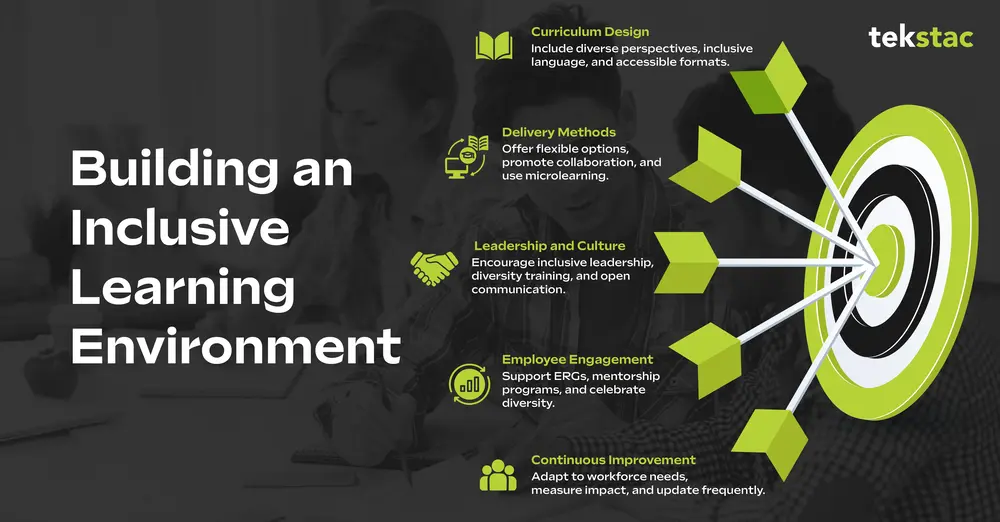
1. Curriculum Design
If the curriculum is well designed, inclusion is set by having diverse perspectives and accessible materials. A producer of training content should provide examples and case studies of training content with diverse cultural backgrounds, genders, and abilities.
This means employees will see their own realities through the learning experience.
- Diverse perspectives: Applying use cases and examples that illustrate diverse views and lived experiences.
- Inclusive language: Don’t use gendered or stereotypical words to make everyone feel accepted inside.
- Accessibility features: Offer the content in variant formats such as captions, alternative text, and audio descriptions.
2. Delivery Methods
Delivery can become the end-all for inclusivity. Designs for the various delivery options are flexible, while approaches to deliveries are collaborative, accommodating the cooperation of many perspectives. Microlearning modules break complex concepts down into bite-size digestible modules that ensure everyone has some form of access.
- Flexible options: For remote employees, offer online; for those with easy travel, in person; and offer blended to meet employee needs
- Collaborative learning: Provide opportunities for cross-cultural and interdisciplinary interaction through group activities.
- Microlearning modules: Break lengthy training into little, manageable bites that are more palatable to adult brains.
3. Leadership and Culture
Inclusive learning environments are fostered by leadership. Employees feel the effect when the executives back inclusivity. By regularly training all leaders and teams on unconscious bias and a welcoming culture, we ensure they’re equipped for this—see how our Inclusive Leadership Upskilling & Reskilling Programs support this effort.
McKinsey & Company states that the companies that train for Diversity perceive a 19% increase in employee engagement.
- Executive buy-in: Lead with inclusivity by driving leaders to lead inclusively, hold themselves accountable, and be accountable for making inclusive efforts.
- Diversity training: Offers training to learn to tackle unconscious bias and be culturally aware.
- Open communication: Create safe spaces for giving and receiving feedback and discussing learning initiatives.
4. Employee Engagement
Inclusive learning environments are positively influenced by engagement initiatives through which employees feel valued and supported. Further programs like Employee Resource Groups (ERGs) and mentorship initiatives strengthen the experience of belonging and encourage cross-cultural exchange while celebrating various things that reinforce the understanding of inclusion.
- ERGs: Facilitating groups driven by employees with shared identities.
- Mentorship programs: Mix people from different backgrounds to learn mutually.
- Celebrate diversity: Identify cultural holidays and celebrate diversifying perspectives within your organization.
5. Continuous Improvement
Inclusivity is a never-ending process of refining and changing frequently as needs shift. Some programs can also assess employee needs and track participation, which can help fine-tune the way the programs are crafted and evaluated as to their impact.
As we learn, we improve, and iterative improvements are essential to making learning environments inclusive and effective.
- Adapt to the workforce: Try to know the particular needs of your team for data.
- Measure impact: Use feedback to assess program success.
- Iterate frequently: Align Changing Workforce Dynamics with Best Practices of Up-to-date materials and methods.
The ability to understand learning and development trends, such as those presented in this blog, can inform the creation of these flexible options to meet future workforce needs.
Overcoming Challenges in Building Inclusivity
Inclusivity in learning environments can be challenging, but resistance to change and limited resources are just a couple of challenges that come with it.
Thinking about it in reverse, approval often comes down to fear of the unknown or discomfort with change, which means leadership supplements and clear communication are crucial to gain buy-in.
1. Addressing Resistance to Change
Change can be uncomfortable. Resistance often stems from fear of the unknown. To address this, leadership should be involved early, and the benefits of an inclusive learning environment should be communicated. Highlight how inclusivity can boost team morale, productivity, and the company’s bottom line.
Change works best when everyone’s on board, so gather input from employees and integrate their feedback into the process.
2. Handling Limited Resources
Tight budgets shouldn’t stop inclusivity. Leverage existing tools like free online resources or in-house expertise to create cost-effective solutions. For instance, mentorship programs can pair seasoned employees with newer hires, offering a wealth of knowledge without the need for external trainers.
Creative thinking goes a long way when funds are limited. Even small adjustments, like rearranging training schedules to accommodate different time zones, can make a difference.
3. Measuring Impact
How do you know if your efforts are working? Measuring the impact of inclusivity initiatives is crucial. Tools like feedback surveys, quizzes, and peer evaluations can help track progress.
Additionally, celebrate and share success stories to motivate others. Seeing tangible results fosters enthusiasm and encourages a sustained commitment to inclusivity.
Why Inclusive Learning Matters More Than Ever
Creating an inclusive learning environment appears to be a trendy concept, but it’s also a transformative strategy that positively impacts both employees and organizations. When businesses put diversity and inclusion at the top of their learning curve, they can uncover immense value, collaborate, and innovate.
Show your team that you’re invested in leveling the playing field for their growth and happiness by investing in equitable learning opportunities. And the long-term value? A workforce that will give you more happiness and engagement will help your business skyrocket to greater heights.
Don’t wait to make positive changes. Start building a workplace where everyone feels valued and can grow. Want to learn more about creating an inclusive environment?
Visit tekstac for practical strategies that can help your team thrive.
FAQs on Inclusive Learning Environment
1. What does an inclusive learning environment mean in the workplace?
An inclusive learning environment is a space where all employees feel respected, supported, and able to learn—regardless of their background, identity, or abilities.
2. How can companies build an inclusive learning environment?
By designing inclusive curricula, offering flexible delivery methods, encouraging leadership support, gathering regular feedback, and promoting employee engagement programs.
3. What are the characteristics of an inclusive learning environment?
- Culturally responsive content
- Multiple formats for accessibility (e.g., captions, audio)
- Respect for diverse opinions
- Safe and open participation
- Leadership commitment to equity and inclusion


